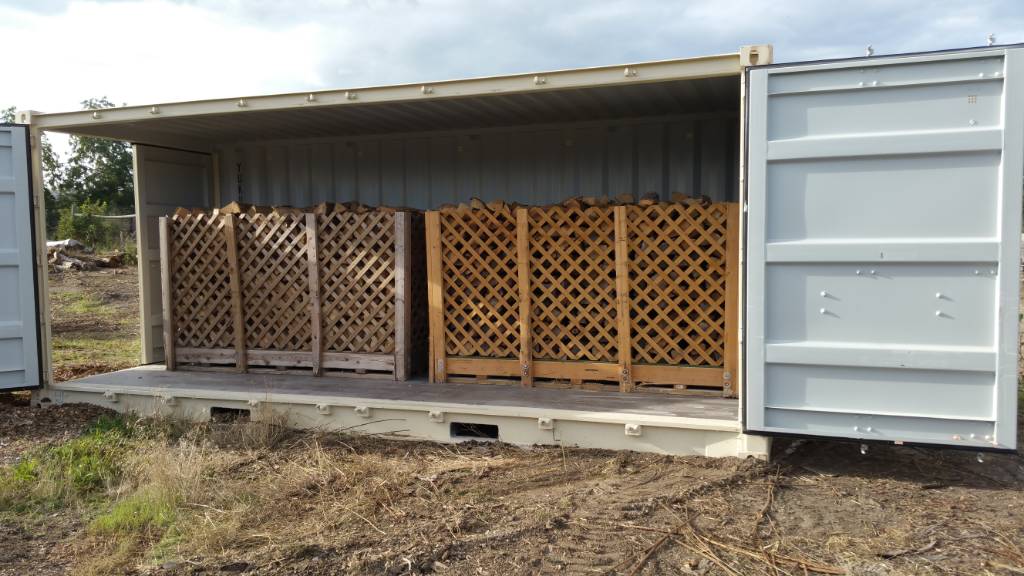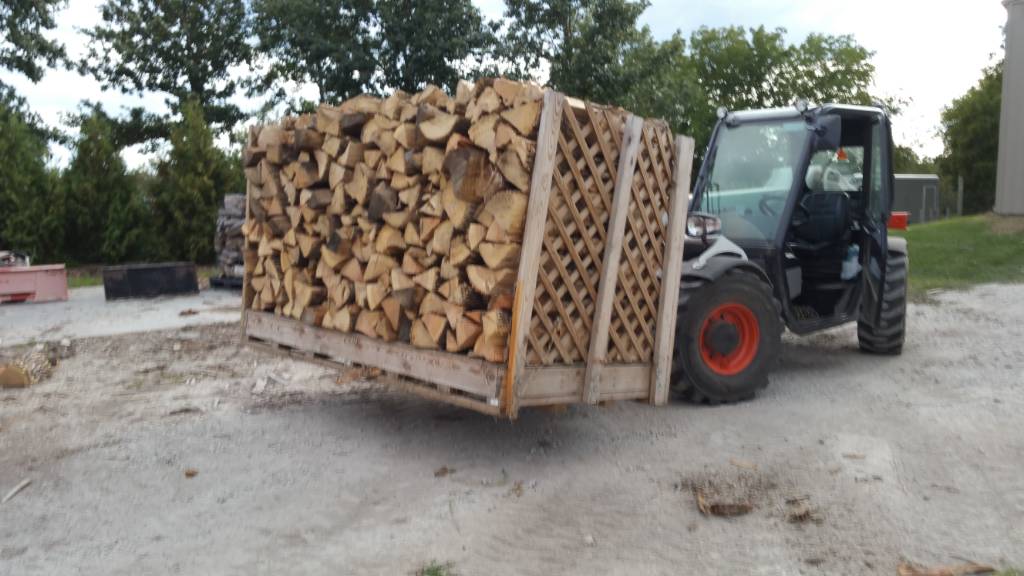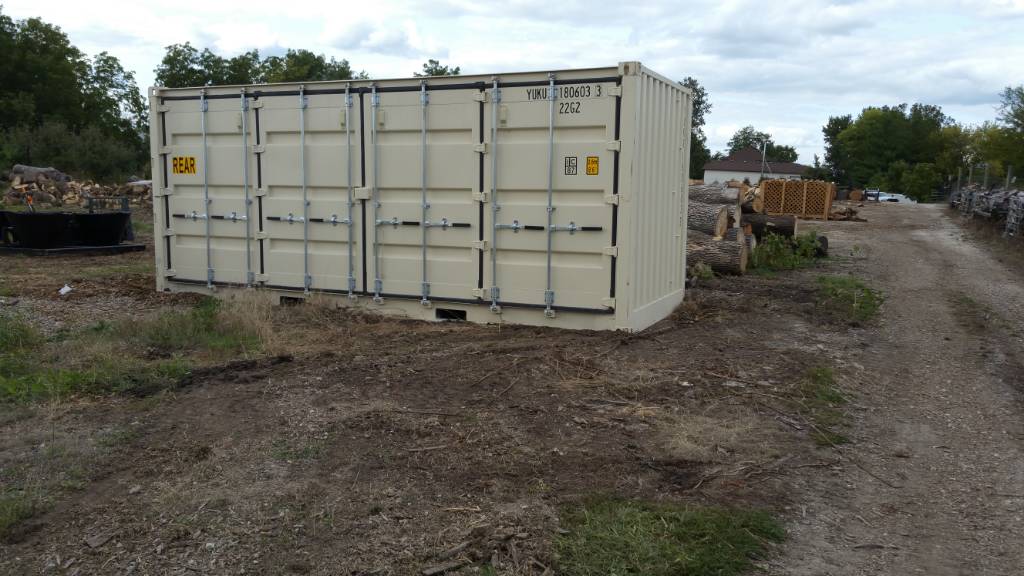You are using an out of date browser. It may not display this or other websites correctly.
You should upgrade or use an alternative browser.
You should upgrade or use an alternative browser.
Fastest way to season firewood?
- Thread starter jrider
- Start date

Help Support Arborist Forum:
This site may earn a commission from merchant affiliate
links, including eBay, Amazon, and others.
AHH it's net, looking via my phone I thought it was the cling film like pallet wrap (do you know what I mean by cling film? I think you have a different term your side of the pond)
Looks like a fantastic tool/system! Never seen anything like that before!
The tarp under stops moisture coming up from the ground I guess?
Looks like a fantastic tool/system! Never seen anything like that before!
The tarp under stops moisture coming up from the ground I guess?
NSMaple1
Addicted to ArboristSite
Sandhill, you likely posted this before but how much wood is on each pallet? Maybe 1/4 cord? I suspect no more?
Anyone have any tricks to seasoning firewood quickly? Not talking about kiln drying.
Cut split and stack it in the sun and wind.
It dry's pretty fast if you split and stack it.
I can get most wood dry in a few months if it's split.
Rounds take much longer and logs even longer then that.
The only wood I handle that takes the longest is post oak.
Mesquite takes a long time as well.
For most part wood does not season or dry unless it is split. It does depend on the climate and weather to a degree. Logs that have been cut and stacked are not dry after 10 years in many cases. We have humidity down to 15% many days during the year. Wood that have been cut into rounds have a pretty good chance on being pretty dry if they are not piled on top of each other. I cut a green growing Pine about a month ago and now it is totally ready to burn, For almost all cases wood needs to be cut split and stacked ASAP. No more than two rows wide to allow for air circulation. If you know that you will have some freezing weather then that is the perfect time to get your wood dry. Thanks
The tarp under stops moisture coming up from the ground I guess?
The tarp is 6' square. Corners folded as shown (folded under actually) and stitched so I can get my arm through the tunnel that that makes. Tarps go on top and not under pallets. Then a long loop of baling twine through the corners and around the bale to hold the tarp secure and still let air flow under it from the sides. The photo of the tarp on the ground does not have the corners stitched. That photo was the day I came up with how to secure them, and do it as simply as I could think of. I made hundreds more of covers last winter, and it became a lot of work time wise cutting and sewing. So far I've gone through a role of twine, 4,500 feet, at about 17' per pallet, and several very large tarps. Soon I will be selling firewood I covered last fall, and can begin reusing the covers, same as the pallets. The main point is however, it seems to be working very well for seasoning, and keeping leaves out as well. The only thing about ground moisture is rotting what sits on it, pallets included. So far no indication of this, but one year is too short of measure to judge yet on the gravel. Gravel does hold moisture well when shaded.how much wood is on each pallet? Maybe 1/4 cord? I suspect no more?
Each pallet stacks to a little over 1/4 cord. Four of the drums used for palletizing a cord equals 226 cu. ft. loose thrown. (well over what is commonly thought to be 180-200 cu. ft. loose thrown per cord)
I'm not saying, or implying, this is the fastest way to season firewood. It is working about the same as the large racks I was using if they were covered. Uncovered in both cases, the pallets are much better. The firewood in the racks was tightly stacked three rows deep, and uncovered the top half of the middle row I found to be wet and heavy when delivering even after a year, from rain/snow and lack of sun/air.
I think the fastest way to season is to process (cut/split) in March/April/May. I keep looking at the wood I did this past spring, compared to last fall, and I don't see, feel, or hear much difference.

$202.29
Oregon Yukon Chainsaw Safety Protective Bib & Braces Trousers - Type A Protection, Dark Grey, Large
Express Shipping ⭐⭐⭐⭐⭐

$63.99
ZELARMAN Chainsaw Chaps Apron Wrap 8-layer for Men/Women Loggers Forest Workers Protective Chain Saw Pants Adjustable
QUALITY GARDEN & HAND TOOLS

$337.83
$369.99
WEN Electric Log Splitter, 6.5-Ton Capacity with Portable Stand (56208)
Amazon.com

$14.97
$19.99
Dremel A679-02 Sharpening Attachment Kit, For Sharpening Outdoor Gardening Tools, Chainsaws, and Home DIY Projects,
Amazon.com

$38.99 ($0.39 / Foot)
Arborist Rope Climbing Rope Swing for Tree(1/2in x 100ft) Logging Rope 48 Strands for Pull, Swing, Knot (Orange)
SDFJKLDI

$215.05
$233.19
Weaver Leather WLC 315 Saddle with 1" Heavy Duty Coated Webbing Leg Straps, Medium, Brown/Red
Amazon.com

$26.99 ($0.22 / Foot)
$29.99 ($0.25 / Foot)
VEVOR Double Braided Polyester Rope, 1/2 in x 120 ft, 48 Strands, 8000 LBS Breaking Strength Outdoor Rope, Arborist Rigging Rope for Rock Hiking Camping Swing Rappelling Rescue, Orange/Black
Amazon.com

$36.99
$59.99
SPEED FORCE Kindling Splitter-Log Splitter-FireWood Splitter–Power Log Splitter Blade Made from CAST Steel, Black Large
SpeedForceUSA

$39.99
$79.99
SPEED FORCE Kindling Splitter Log Splitter FireWood Splitter Power Log Splitter, Long Life CAST Steel Blade, Black (XL)
SpeedForceUSA

$79.99
ZELARMAN Chainsaw Chaps 8-layer Protective Apron Wrap Adjustable Chainsaw Pants/Chap for Loggers Forest Workers Class A
QUALITY GARDEN & HAND TOOLS
LondonNeil: Which London are you in?
If London, England, then you might find a used Posch rather cheap. I found some discussion on Arbtalk, which lead me to some 'equipment for sale' sites in Europe. It seems to be a German company, but some units made in Austria.
If London, England, then you might find a used Posch rather cheap. I found some discussion on Arbtalk, which lead me to some 'equipment for sale' sites in Europe. It seems to be a German company, but some units made in Austria.
The fastest way that I can dry firewood is to split it, throw it into a random pile atop pallets, and let it dry in the sun and wind. Piled atop the pallets, it's off the ground, and the sun and wind do the rest. I have found that throwing a tarp over the pile is worthless.
Some wood species can be split when green, others cannot and require some drying in the round. American elm and cottonwood come to mind. I wait until the bark starts to fall off these two species before I split them.
Some wood species can be split when green, others cannot and require some drying in the round. American elm and cottonwood come to mind. I wait until the bark starts to fall off these two species before I split them.
Thanks guys! Appreciate all the input. we have a couple of sunny days coming then a few showers..I'll start splitting it tomorrow and should have it done before the showers get here. As my splitter is in the shed, I don't want to split then put it back out into the sun then move it back into the shed...We should be good. There is some pine in there as well which is already pretty dry. 
Cheers
Cheers
KiwiBro
Mill 'em, nails be damned.
You want it to dry fast? Get it wet. No, seriously. Cut and split it green, leave the splits in the river (it's Canada, there are rivers everywhere ?  ) for a few days, pull it out absolutely saturated, then watch it dry faster than anything else. No, really. It works. This Summer, I'll put about 30 cords of gum firewood in a river that runs through a property I'm cutting on and it will be seasoned come Winter.
) for a few days, pull it out absolutely saturated, then watch it dry faster than anything else. No, really. It works. This Summer, I'll put about 30 cords of gum firewood in a river that runs through a property I'm cutting on and it will be seasoned come Winter.
Yes London England. I'm just a home owner doing my own couple of cords though, but like to see a well thought out system and good kit, it's interesting.
It really dose not mater where you live. Splitting and stacking where it's well ventilated and lots of sun is going to give everyone the best natural air dry results.
I simply stock and rotate enough wood so that dry time is not a factor.
If you live where you have short dry times you can keep your stock lower, but if your area takes more time, you simply have to keep dry wood coming up in the rotation.
The weather conditions play a big roll to. You may have 8 to 10 years of dry conditions, then have wet conditions for 1 or 2 years in a row. Dry times will very, even in the same location.
You adapt and adjust to your condition and usage.
I simply stock and rotate enough wood so that dry time is not a factor.
If you live where you have short dry times you can keep your stock lower, but if your area takes more time, you simply have to keep dry wood coming up in the rotation.
The weather conditions play a big roll to. You may have 8 to 10 years of dry conditions, then have wet conditions for 1 or 2 years in a row. Dry times will very, even in the same location.
You adapt and adjust to your condition and usage.
I am for burning Ash. But for kicks and giggles I just put two cord of stacked wood in a shipping container last week. The 20 ft container has 12 vent holes.
Will see how it goes. Pallets are 4 x 8 x4 each. Mix of Ash white oak and honey locust.



Sent from my SM-N950U using Tapatalk
Will see how it goes. Pallets are 4 x 8 x4 each. Mix of Ash white oak and honey locust.



Sent from my SM-N950U using Tapatalk
Sit that container on blocks and put a few vents in the floor so air will circulate from the bottom out the top. paint it flat black, and I bet it will work very well.
Sit that container on blocks and put a few vents in the floor so air will circulate from the bottom out the top. paint it flat black, and I bet it will work very well.
Yeah I can attest to what a temp difference that makes
- Joined
- Jan 14, 2002
- Messages
- 4,800
- Reaction score
- 12,596
- Location
- North of Goderich, Ontario, Canada
Ken, that's why I'm glad that my hair is turning gray. It was just so hot when it was black. I'm also glad it's thinning out too, saves me money on shampoo. And I can work longer at dark as the sun reflects off my receding hair line allowing me to see better.
Ken, that's why I'm glad that my hair is turning gray. It was just so hot when it was black. I'm also glad it's thinning out too, saves me money on shampoo. And I can work longer at dark as the sun reflects off my receding hair line allowing me to see better.
I keep wood stacked under a shed, most of the time. Shed will hold enough for two winters and I burn out of one end one year and the other end the next winter, so the wood is always rotated. Right now, all the wood is stacked in the middle of the shed as I have burnt two winters out of it and had wood left over. When the shed is full, wood is stacked outside, uncovered. I am burning the outside stacked wood now instead of the shed covered wood. Its dry and seasoned. I figure why move the wood inside the shed when I can move it inside the house one load at a time, put close to the wood stove and any rain water drys out almost over nite. I have rounds and logs that need to be bucked and split and I pull small rounds out that will fit in the stove for overnite fires, The small rounds have dried pretty well over the summer as they are piled in full sun. The bigger, unsplit stuff is probably green if I split it. It will get split and stacked inside the shed, there is probably enough to refill one end of the shed so it will have another year to season before I need it.Hi guys. I live in British Columbia, so I deal with ALOT of rain. The fastest, and sometimes only way for me to dry my firewood is to build a big chimney out of wood around my firepit. Then I light 'er up. Obviously this has to be done carefully. Some people might call me stupid but this method works like a charm.
My good friend has his own way of seasoning firewood for his potbelly stove. He watches me cut all my logs to length, and I collect and throw the short cutoffs into his big scrap bin shed with an open end that faces the setting sun. These are usually rounds less than 6" in length and other odd-ball chunks. All of them dry very fast, and I can't really sell them because everyone wants firewood log lengths. So, my friend cuts and splits practically nothing and fills his stove with these leftover shorties and chunks. His potbelly stove gobbles them up like gumdrops and he keeps his house warm as toast.
You have to admire ingenuity like that.
You have to admire ingenuity like that.
I rarely have anything to do with green wood, but when we have rain it is often a mess. Last winter we started getting rain in November and it lasted until April so everything got pretty soggy. I try to keep the tops of the rows covered with tarps. When the temp reaches 30f or less I set fans along the rows. In less then a week the wood is very usable. Thanks
Similar threads
- Replies
- 30
- Views
- 2K
- Replies
- 19
- Views
- 2K
- Replies
- 32
- Views
- 2K
- Replies
- 8
- Views
- 1K
- Replies
- 10
- Views
- 2K















































